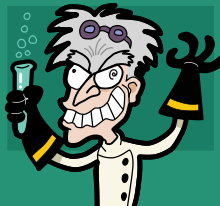Mad scientist

Mad scientist (also mad doctor or mad professor) is a caricature of a scientist who is described as "mad" or "insane" owing to a combination of unusual or unsettling personality traits and the unabashedly ambitious, taboo and/or hubristic nature of their experiments. As a motif in fiction, the mad scientist may be villainous (evil genius) or antagonistic, benign or neutral; may be insane, eccentric, or clumsy; and often works with fictional technology or fails to recognize or value common human objections to attempting to play God. Some may have benevolent or good-spirited intentions, even if their actions are dangerous or questionable, which can make them accidental villains.
History
The prototypical fictional mad scientist was Victor Frankenstein, creator of his eponymous monster,[1][2][3] who made his first appearance in 1818, in the novel Frankenstein, or the Modern Prometheus by Mary Shelley. Though Frankenstein is a sympathetic character, the critical element of conducting experiments that cross "boundaries that ought not to be crossed", heedless of the consequences, is present in Shelley's novel. Frankenstein was trained as both alchemist and modern scientist which makes him the bridge between two eras of an evolving archetype. The book is said to be a precursor of a new genre, science fiction,[4][5] although as an example of gothic horror[6][7][8][9] it is connected with other antecedents as well.
1896 saw the publication of H. G. Wells' The Island of Doctor Moreau, in which the titular doctor—a controversial vivisectionist—has isolated himself entirely from civilisation in order to continue his experiments in surgically reshaping animals into humanoid forms, heedless of the suffering he causes.[10]

Fritz Lang's movie Metropolis (1927) brought the archetypical mad scientist to the screen in the form of Rotwang, the evil genius whose machines gave life to the dystopian city of the title.[11] Rotwang's laboratory influenced many subsequent movie sets with its electrical arcs, bubbling apparatus, and bizarrely complicated arrays of dials and controls. Portrayed by actor Rudolf Klein-Rogge, Rotwang himself is the prototypically conflicted mad scientist; though he is master of almost mystical scientific power, he remains slave to his own desires for power and revenge. Rotwang's appearance was also influential—the character's shock of flyaway hair, wild-eyed demeanor, and his quasi-fascist laboratory garb have all been adopted as shorthand for the mad scientist "look". Even his mechanical right hand has become a mark of twisted scientific power, echoed notably in Stanley Kubrick's Dr. Strangelove and in the novel The Three Stigmata of Palmer Eldritch (1965) by Philip K. Dick.

A recent survey of 1,000 horror films distributed in the UK between the 1930s and 1980s reveals mad scientists or their creations have been the villains of 30 percent of the films; scientific research has produced 39 percent of the threats; and, by contrast, scientists have been the heroes of a mere 11 percent.[12]
See also
| Wikimedia Commons has media related to Mad scientists. |
- Boffin
- Crank (person)
- Creativity techniques
- Creativity and mental illness
- List of mad scientists
- Megalomania
References
- ↑ "Encyclopedia Britannica - Frankenstein". Retrieved 10 November 2015.
- ↑ Clemens, Valdine. Return of the Repressed, The: Gothic Horror from The Castle of Otranto to Alien. p. 93. Retrieved 10 November 2015.
- ↑ Wilson, Daniel H.; Long, Anna C. The Mad Scientist Hall of Fame. p. 100. ISBN 978-0806528793. Retrieved 10 November 2015.
- ↑ Abrams, M.H.; Harpham, Geoffrey. A Glossary of Literary Terms. p. 355. Retrieved 10 November 2015.
- ↑ Corbett, Robert. "Romanticism and Science Fictions". Romanticism On the Net. doi:10.7202/005970ar.
- ↑ Tweg, Sue; Shelley, Mary Wollstonecraft; Edwards, Kim. Frankenstein. p. 13. Retrieved 10 November 2015.
- ↑ Jelinek, Kenneth P. (1997). Gothic Horror and Scientific Education in Mary Shelley's Frankenstein.
- ↑ "Frankenstein as a Gothic Novel". Retrieved 10 November 2015.
- ↑ "Frankenstein as a Gothic Fiction". bachelorandmaster.com. Retrieved 10 November 2015.
- ↑ "Novels: The Island of Doctor Moreau". Retrieved 10 November 2015.
- ↑ Geraghty, Lincoln. American Science Fiction Film and Television. Retrieved 10 November 2015.
- ↑ Christopher Frayling, New Scientist, 24 September 2005.
Bibliography
- Garboden, Nick (2007). Mad Scientist or Angry Lab Tech: How to Spot Insanity. Portland: Doctored Papers. ISBN 1-56363-660-3.
- Haynes, Roslynn Doris (1994). From Faust to Strangelove: Representations of the Scientist in Western Literature. Baltimore: Johns Hopkins University Press. ISBN 0-8018-4801-6.
- Christopher Frayling – Mad, Bad and Dangerous?: The Scientist and the Cinema (Reaktion Books, 2005) ISBN 1-86189-255-1
- Junge, Torsten; Doerthe Ohlhoff (2004). Wahnsinnig genial: Der Mad Scientist Reader. Aschaffenburg: Alibri. ISBN 3-932710-79-7.
- Norton, Trevor (2010). Smoking Ears and Screaming Teeth. (A witty celebration of the great eccentrics ...). Century. ISBN 978-1-84605-569-0
- Schlesinger, Judith (2012). The Insanity Hoax: Exposing the Myth of the Mad Genius.[1] Ardsley-on-Hudson, N.Y. Shrinktunes Media ISBN 978-0-98369-824-1
- Schneider, Reto U. (2008). The Mad Science Book. 100 Amazing Experiments from the History of Science. London: Quercus. ISBN 978-1-84724-494-9
- Tudor, Andrew (1989). Monsters and Mad Scientists: A Cultural History of the Horror Movie. Oxford: Blackwell. ISBN 0-631-15279-2.
- Weart, Spencer R. (1988). Nuclear Fear: A History of Images. Cambridge, Mass.: Harvard University Press.
External links
- Analyzing the culture motif
- Gary Hoppenstand, "Dinosaur Doctors and Jurassic Geniuses: The Changing Image of the Scientist in the Lost World Adventure"
- The Scarecrow's Brain – images of the scientist in film, Christopher Frayling
- Breaking Down the Stereotypes of Science by Recruiting Young Scientists
- The Mad Scientist Database with links and Looks
- Mad Science Experiments
- TV Tropes article on the Mad Scientist stock character
- ↑ James T. Webb, Ph.D. (September 12, 2012). "A Book Review of The Insanity Hoax: Exposing the Myth of the Mad Genius". The National Psychologist. Retrieved 28 May 2015.